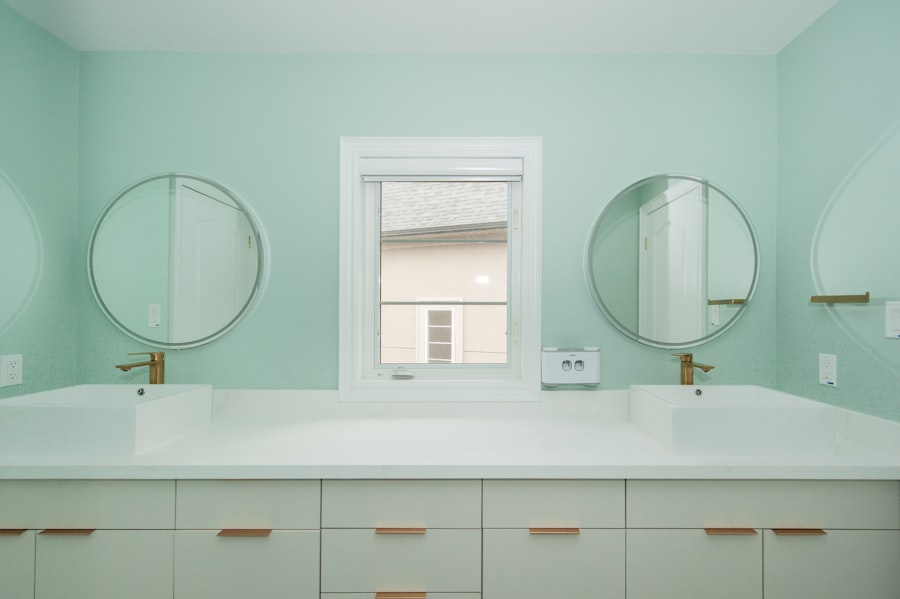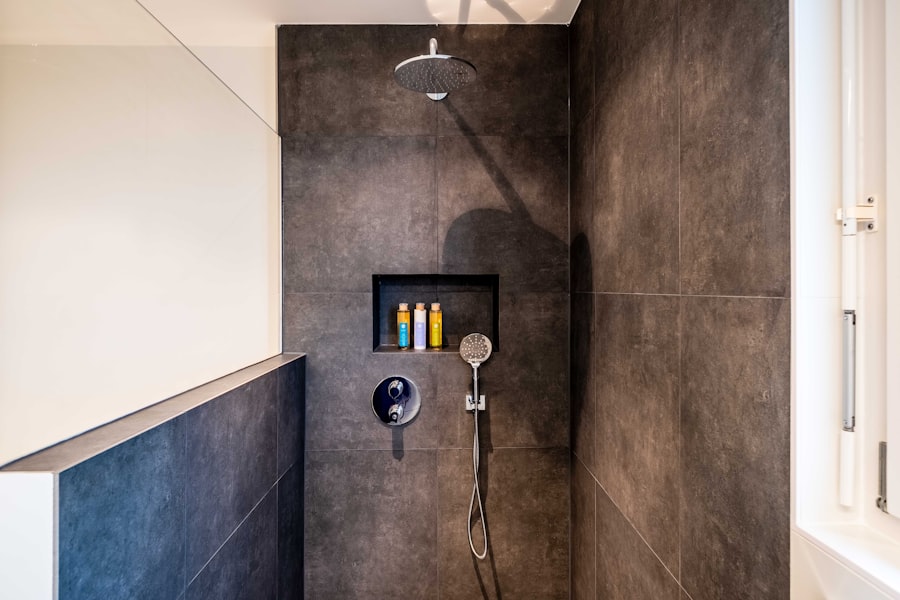A restroom remodel is often seen as a luxury, but it can significantly enhance the functionality and aesthetic appeal of a home. Over time, restrooms can become outdated, with fixtures that no longer work efficiently or styles that feel stale. A remodel not only revitalizes the space but also increases the overall value of the property.
According to the National Association of Realtors, a well-executed bathroom renovation can yield a return on investment of up to 70%. This statistic underscores the financial benefits of investing in a restroom remodel, making it a wise choice for homeowners looking to improve their living environment while also considering future resale value. Moreover, a restroom remodel can address practical issues that arise from wear and tear.
Leaky faucets, outdated plumbing, and insufficient storage can create frustration in daily routines. By updating these elements, homeowners can create a more efficient and enjoyable space. For instance, replacing old plumbing fixtures with modern, water-efficient models not only conserves water but also reduces utility bills.
Additionally, a remodel allows for the incorporation of contemporary design trends that enhance comfort and usability, such as walk-in showers or double vanities, which cater to the needs of modern families.
Key Takeaways
- A restroom remodel enhances both functionality and home value.
- Selecting a skilled professional ensures quality and smooth project execution.
- Proper budgeting helps manage costs and avoid unexpected expenses.
- Thoughtful design and layout improve space utilization and user experience.
- Choosing durable fixtures and materials adds longevity and style to the restroom.
Finding the Right Professional for the Job
Selecting the right professional for a restroom remodel is crucial to ensuring that the project runs smoothly and meets expectations. Homeowners should begin by researching local contractors who specialize in bathroom renovations. Online reviews, testimonials, and portfolios can provide insight into a contractor’s previous work and customer satisfaction levels.
It is advisable to seek out professionals who have experience with projects similar in scope and style to what you envision for your own restroom. Once potential contractors have been identified, it is essential to conduct interviews to gauge their expertise and communication skills. During these discussions, homeowners should inquire about the contractor’s approach to project management, timelines, and how they handle unexpected challenges.
A good contractor will be transparent about their process and willing to provide references from past clients. Additionally, checking for proper licensing and insurance is vital to protect against potential liabilities during the remodel. Establishing a good rapport with the chosen professional can lead to a more collaborative and successful remodeling experience.
Budgeting for Your Restroom Remodel

Creating a realistic budget is one of the most critical steps in planning a restroom remodel. Homeowners should start by determining how much they are willing to spend and what aspects of the remodel are most important to them. A detailed budget should include costs for materials, labor, permits, and any unexpected expenses that may arise during the project.
It is wise to allocate an additional 10-20% of the total budget for contingencies, as unforeseen issues often occur in renovation projects. To gain a clearer understanding of potential costs, homeowners can research average prices for various materials and fixtures. For example, the cost of tiles can vary significantly based on quality and design; high-end porcelain tiles may cost more than standard ceramic options.
Additionally, labor costs can fluctuate based on the complexity of the project and local market rates. By gathering estimates from multiple contractors and comparing them against their budget, homeowners can make informed decisions about where to allocate funds and where they might need to compromise.
Design and Layout Considerations
| Design Aspect | Metric | Recommended Value/Range | Notes |
|---|---|---|---|
| Grid System | Number of Columns | 12 | Commonly used for responsive layouts |
| Typography | Font Size (Body Text) | 16px – 18px | Ensures readability on most devices |
| Typography | Line Height | 1.4 – 1.6 | Improves text legibility |
| Color Contrast | Contrast Ratio | At least 4.5:1 | Meets accessibility standards (WCAG AA) |
| Spacing | Margin and Padding | 8px, 16px, 24px increments | Consistent spacing improves visual hierarchy |
| Layout | Max Content Width | 1140px – 1200px | Optimal for desktop readability |
| Navigation | Clickable Area Size | Minimum 44px x 44px | Enhances usability on touch devices |
| Images | File Size | Under 200KB | Improves page load speed |
| Responsive Design | Breakpoint Widths | 320px, 768px, 1024px, 1440px | Common device widths for responsiveness |
The design and layout of a restroom are pivotal in creating a space that is both functional and visually appealing. Homeowners should consider how they use their restroom daily and what features would enhance their experience. For instance, if multiple family members share the space, incorporating dual sinks can alleviate morning congestion.
Additionally, considering the flow of movement within the restroom is essential; ensuring that doors do not swing into fixtures or impede access can significantly improve usability. When it comes to aesthetics, homeowners should think about their personal style and how it aligns with current design trends. Popular choices include minimalist designs with clean lines and neutral color palettes or more eclectic styles that incorporate bold colors and unique fixtures.
Lighting is another critical aspect; natural light can make a restroom feel more spacious and inviting, while layered lighting—such as ambient, task, and accent lighting—can enhance functionality and mood. Ultimately, the design should reflect the homeowner’s personality while also catering to practical needs.
Choosing the Right Fixtures and Materials
Selecting fixtures and materials is one of the most exciting yet challenging aspects of a restroom remodel. The choices made here can dramatically influence both the functionality and aesthetic appeal of the space. When choosing fixtures such as sinks, toilets, and faucets, homeowners should prioritize quality and durability alongside style.
For example, opting for a low-flow toilet not only conserves water but also contributes to lower utility bills over time. Materials play an equally important role in defining the restroom’s character. Tile choices can range from classic ceramic to luxurious marble or trendy glass mosaics.
Each material has its own maintenance requirements and durability levels; therefore, homeowners should consider how much time they are willing to invest in upkeep. Additionally, countertops made from quartz or granite offer both beauty and resilience against moisture and stains. By carefully selecting fixtures and materials that align with their lifestyle and design preferences, homeowners can create a restroom that is both beautiful and practical.
Maximizing Space and Functionality

In many homes, restrooms are often limited in size, making it essential to maximize space without sacrificing functionality. Clever design strategies can help create an illusion of space while ensuring that all necessary features are included. For instance, wall-mounted vanities can free up floor space, making the room feel larger while providing essential storage solutions.
Similarly, using large-format tiles can reduce grout lines and create a seamless look that enhances the perception of space. Storage solutions are also critical in maximizing functionality within a restroom. Built-in shelves or cabinets can be designed to fit snugly into corners or above toilets, utilizing otherwise wasted space effectively.
Additionally, incorporating multi-functional furniture—such as benches that double as storage—can help keep the area organized while providing additional seating when needed. By focusing on innovative storage solutions and strategic design choices, homeowners can transform even the smallest restrooms into efficient and stylish spaces.
Adding Luxury and Comfort to Your Restroom
Incorporating elements of luxury into a restroom remodel can elevate the overall experience of using the space. Homeowners may consider features such as heated floors or towel warmers that add an extra layer of comfort during colder months. A rainfall showerhead or a freestanding soaking tub can transform an ordinary bathroom into a spa-like retreat where one can unwind after a long day.
Additionally, thoughtful touches such as high-quality linens, elegant lighting fixtures, or custom cabinetry can enhance the luxurious feel of the restroom. Choosing calming colors or incorporating natural elements like plants can create an inviting atmosphere that promotes relaxation. The goal is to create a sanctuary where homeowners can escape from daily stresses while enjoying their personal space.
Completing the Project and Enjoying the Results
Once the remodeling project reaches completion, it is time for homeowners to enjoy their newly transformed restroom. The satisfaction derived from seeing one’s vision come to life is often unparalleled; however, it is essential to take time to appreciate all aspects of the remodel—from design elements to functional improvements. Hosting friends or family in this newly renovated space can provide an opportunity to showcase the hard work invested in creating it.
Moreover, maintaining open communication with contractors during the final stages ensures that any last-minute adjustments or touch-ups are addressed promptly. After settling into the new restroom environment, homeowners may find themselves inspired to continue enhancing their home further or even embarking on additional renovation projects elsewhere in their living space. Ultimately, a successful restroom remodel not only improves daily routines but also enriches overall home life by creating a beautiful and functional environment tailored to individual needs.




